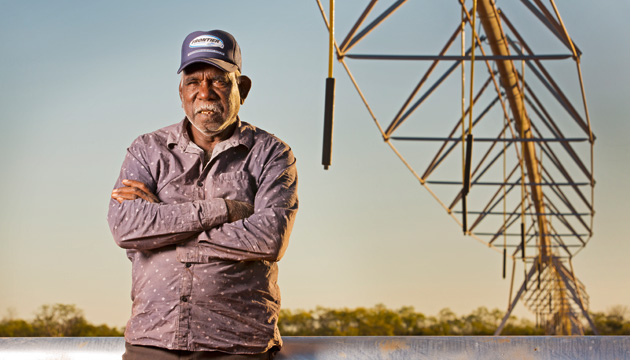A new focus on using groundwater to irrigate fodder crops has the potential to change the face of the Kimberley pastoral industry.
Story by Nathan Dyer
On a warm dry-season afternoon in the Kimberley, WA, former stockman Kevin Brooking leans on an old water tank on the banks of the Fitzroy River. “There was a whole line of sprinklers through here, right up to that fence line,” Kevin says, explaining how this place, known as ‘Old Bungardi’, was once the site of a thriving hay-growing enterprise.
A Bunuba man who grew up here on Brooking Springs, north-east of Fitzroy Crossing, Kevin spent his working life mustering cattle across the Kimberley. Although Old Bungardi is today little more than a memory, Kevin is optimistic about plans to use groundwater to develop agriculture across Bunuba country. “If we could grow hay and sorghum here we could supply surrounding stations, and because of the location they wouldn’t have such high freight costs,” he says.
The Fitzroy Valley is one of four Kimberley focus areas under the Western Australian Government’s $40 million Water for Food initiative, which is part of the State’s Royalties for Regions scheme. The project includes land and water investigations, technology research and development, and increased engagement with private landholders to expand irrigation developments.
Minister for Water, Mia Davies, says with the global population expected to reach 9.55 billion people by 2050, food security is a concern for many countries that rely on imports. “Western Australia can be part of the long-term food solution, but only if we dramatically intensify and expand production through the use of irrigation,” she says. The Department of Water estimates there are more than 1000 gigalitres of sustainable water resources in the Kimberley and Pilbara, alone.
Broome-based strategic project manager, Rob Cossart, says using groundwater to irrigate fodder can dramatically enhance Kimberley beef production and profit, by smoothing out the seasonal variations in feed availability and quality. “The industry can have more flexibility to manage its herd, keep its herd in better condition, grow out stock quicker, and have greater choice when it turns off stock to market,” he says.
Although irrigation developments exist on stations in the region, including Kilto, Gogo and Liveringa, Rob says Water for Food is about developing that model further. “Here in the Kimberley, and in the Pilbara, we have huge groundwater aquifers that have never been utilised for agriculture, so a big part of Water for Food is understanding those resources."
This story excerpt is from Issue #109
Outback Magazine: Oct/Nov 2016










